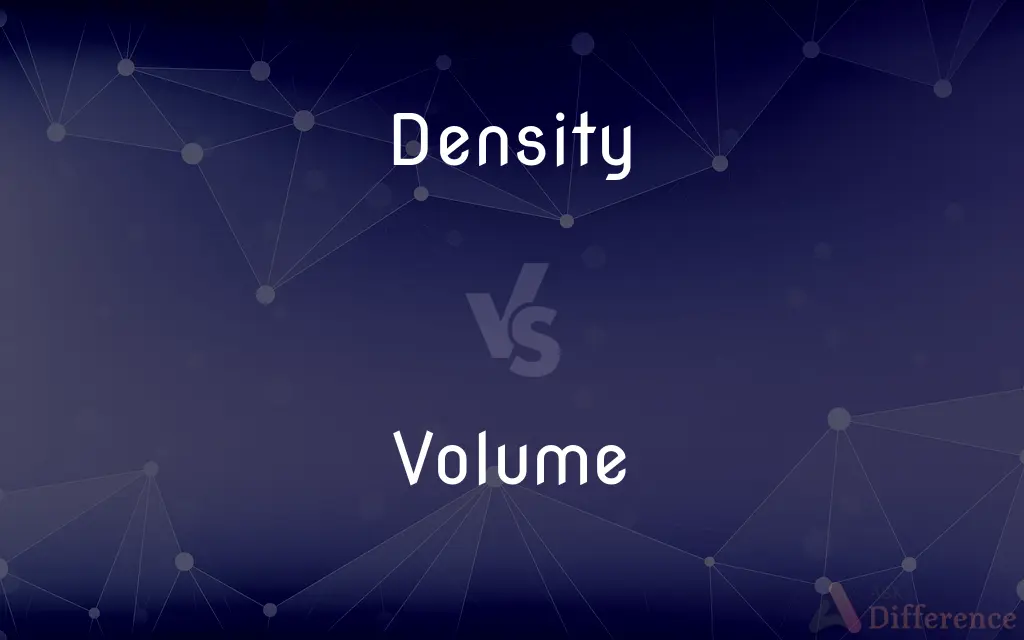Density vs. Volume — What's the Difference?
Edited by Tayyaba Rehman — By Urooj Arif — Updated on April 16, 2024
Density is a measure of mass per unit volume, highlighting how compact a substance is; volume refers to the space that a substance or object occupies, irrespective of its mass.

Difference Between Density and Volume
Table of Contents
ADVERTISEMENT
Key Differences
Density is defined as the mass of an object divided by its volume, used to describe how tightly matter is packed within an object. Volume, on the other hand, simply measures the amount of space that an object occupies, regardless of its mass.
While density provides insight into the material composition of an object, suggesting whether it will float or sink in a fluid, volume is a purely spatial measure and does not imply anything about material properties.
Density is expressed in units like grams per cubic centimeter (g/cm³) or kilograms per cubic meter (kg/m³), depending on the context. Volume is typically measured in cubic meters (m³), liters (L), or cubic centimeters (cm³), reflecting the size of three-dimensional space.
In practical applications, density is crucial in fields like material science and engineering to select appropriate materials based on strength and weight considerations. Volume, whereas, is essential in disciplines like architecture and manufacturing, where the physical space of materials needs to be accounted for.
Understanding the density of a substance can help predict how it will interact with other substances; for instance, oil (less dense) floating on water (more dense). In contrast, volume calculations are vital in tasks like filling containers or measuring liquids.
ADVERTISEMENT
Comparison Chart
Definition
Mass per unit volume
Amount of space an object occupies
Units of Measure
G/cm³, kg/m³
M³, L, cm³
Implication
Indicates compactness and material composition
Indicates size and capacity
Field Relevance
Material science, chemistry
Architecture, manufacturing, fluid mechanics
Physical Property
Intensive property (does not depend on amount)
Extensive property (depends on amount)
Compare with Definitions
Density
Often used to compare the heaviness of materials.
The density of water is 1 g/cm³, which is used as a reference point.
Volume
Used in cooking to measure ingredients.
She measured out two cups of flour by volume.
Density
The ratio of mass to volume in a substance.
Gold has a high density, making it heavy for its size.
Volume
A property that can change with temperature and pressure.
The volume of gases increases with rising temperature.
Density
Critical in determining whether substances will float or sink.
Objects with a density greater than water sink in it.
Volume
The amount of space an object occupies, measured in cubic units.
The volume of a box is calculated as length × width × height.
Density
Calculated using the formula Density = Mass/Volume.
To find the density of a block, divide its mass by its volume.
Volume
Essential in determining how much a container can hold.
The volume of this bottle is 500 milliliters.
Density
A measure indicating how closely packed particles are in a material.
Lead’s high density makes it ideal for radiation shielding.
Volume
Involves formulas specific to the shape of objects.
To calculate the volume of a sphere, use the formula 4/3 πr³.
Density
The density (more precisely, the volumetric mass density; also known as specific mass), of a substance is its mass per unit volume. The symbol most often used for density is ρ (the lower case Greek letter rho), although the Latin letter D can also be used.
Volume
Volume is the quantity of three-dimensional space enclosed by a closed surface, for example, the space that a substance (solid, liquid, gas, or plasma) or 3D shape occupies or contains. Volume is often quantified numerically using the SI derived unit, the cubic metre.
Density
The quality or condition of being dense.
Volume
A collection of written or printed sheets bound together; a book.
Density
The quantity of something per unit measure, especially per unit length, area, or volume.
Volume
One of the books of a work printed and bound in more than one book.
Density
The mass per unit volume of a substance under specified conditions of pressure and temperature.
Volume
A series of issues of a periodical, usually covering one calendar year.
Density
(Computers) A measure of the number of bits that can be stored in a given amount of physical space on a storage medium.
Volume
A unit of written material assembled together and cataloged in a library.
Density
The number of individuals, such as inhabitants or housing units, per unit of area.
Volume
A roll of parchment; a scroll.
Density
The degree of optical opacity of a medium or material, as of a photographic negative.
Volume
The amount of space occupied by a three-dimensional object or region of space, expressed in cubic units.
Density
Thickness of consistency; impenetrability.
Volume
The capacity of such a region or of a specified container, expressed in cubic units.
Density
Complexity of structure or content.
Volume
Amount; quantity:a low volume of business; a considerable volume of lumber.
Density
Stupidity; dullness.
Volume
OftenvolumesA large amount:volumes of praise.
Density
(physics) A measure of the mass of matter contained by a unit volume.
Volume
The amplitude or loudness of a sound.
Density
The ratio of one quantity, representing something of interest, to another quantity representing space, area, or extent in which the thing of interest is distributed.
The number of particles per unit volume of a specified volume can be considered to be the particle density for the specified volume.
Volume
A control, as on a radio, for adjusting amplitude or loudness.
Density
The probability that an outcome will fall into a given range, per unit of that range; the relative likelihood of possible values of a continuous random variable.
Volume
A three-dimensional measure of space that comprises a length, a width and a height. It is measured in units of cubic centimeters in metric, cubic inches or cubic feet in English measurement.
The room is 9x12x8, so its volume is 864 cubic feet.
The proper products can improve your hair's volume.
Density
Stupidity; denseness.
Volume
Strength of sound; loudness.
Please turn down the volume on the stereo.
Volume can be measured in decibels.
Density
The quality of being dense, close, or thick; compactness; - opposed to rarity.
Volume
The issues of a periodical over a period of one year.
I looked at this week's copy of the magazine. It was volume 23, issue 45.
Density
The ratio of mass, or quantity of matter, to bulk or volume, esp. as compared with the mass and volume of a portion of some substance used as a standard.
Volume
A bound book.
Density
Depth of shade.
Volume
A single book of a publication issued in multi-book format, such as an encyclopedia.
The letter "G" was found in volume 4.
Density
The amount per unit size
Volume
A great amount (of meaning) about something.
Density
The spatial property of being crowded together
Volume
(obsolete) A roll or scroll, which was the form of ancient books.
Volume
Quantity.
The volume of ticket sales decreased this week.
Volume
A rounded mass or convolution.
Volume
(economics) The total supply of money in circulation or, less frequently, total amount of credit extended, within a specified national market or worldwide.
Volume
(computing) An accessible storage area with a single file system, typically resident on a single partition of a hard disk.
Volume
(bodybuilding) The total of weight worked by a muscle in one training session, the weight of every single repetition summed up.
Volume
(intransitive) To be conveyed through the air, waft.
Volume
(transitive) To cause to move through the air, waft.
Volume
(intransitive) To swell.
Volume
A roll; a scroll; a written document rolled up for keeping or for use, after the manner of the ancients.
The papyrus, and afterward the parchment, was joined together [by the ancients] to form one sheet, and then rolled upon a staff into a volume (volumen).
Volume
Hence, a collection of printed sheets bound together, whether containing a single work, or a part of a work, or more than one work; a book; a tome; especially, that part of an extended work which is bound up together in one cover; as, a work in four volumes.
An odd volume of a set of books bears not the value of its proportion to the set.
Volume
Anything of a rounded or swelling form resembling a roll; a turn; a convolution; a coil.
So glides some trodden serpent on the grass,And long behind wounded volume trails.
Undulating billows rolling their silver volumes.
Volume
Dimensions; compass; space occupied, as measured by cubic units, that is, cubic inches, feet, yards, etc.; mass; bulk; as, the volume of an elephant's body; a volume of gas.
Volume
Amount, fullness, quantity, or caliber of voice or tone.
Volume
The amount of 3-dimensional space occupied by an object;
The gas expanded to twice its original volume
Volume
The property of something that is great in magnitude;
It is cheaper to buy it in bulk
He received a mass of correspondence
The volume of exports
Volume
Physical objects consisting of a number of pages bound together;
He used a large book as a doorstop
Volume
A publication that is one of a set of several similar publications;
The third volume was missing
He asked for the 1989 volume of the Annual Review
Volume
A relative amount;
Mix one volume of the solution with ten volumes of water
Volume
The magnitude of sound (usually in a specified direction);
The kids played their music at full volume
Common Curiosities
How do you measure volume?
Volume is measured by calculating the space an object occupies using mathematical formulas or by displacement.
What is density used for?
Density is used to identify substances and determine their suitability in various applications based on how compact they are.
Can density be the same for different substances?
Yes, different substances can have the same density if their mass-to-volume ratios are equal.
Why is volume important in shipping?
Volume determines how much space goods will occupy, crucial for planning and cost calculation in shipping.
What makes density an intensive property?
Density is intensive because it does not change with the amount of the substance present.
What is the significance of knowing the density of materials in construction?
It helps in choosing materials that will bear load efficiently while being economical.
Can volume be converted into other measurements?
Volume can be converted into measurements like liters and gallons for liquids.
Does density change with shape changes?
Density remains the same regardless of shape since it depends only on mass and total volume.
How do you find the volume of irregular shapes?
For irregular shapes, volume can be found using water displacement methods.
How is volume used in daily life?
Volume is used to determine how much liquid can fit in containers, among other practical uses.
Is volume affected by external conditions?
Yes, especially for gases, volume can change significantly with temperature and pressure.
What unit is most commonly used for density?
The gram per cubic centimeter (g/cm³) is commonly used for solid materials.
How does density affect transportation of goods?
Higher-density materials may increase transportation costs due to their weight.
What is the relationship between density and buoyancy?
Objects with lower density than the fluid in which they are submerged will float.
Are volume and capacity the same?
Volume refers to the amount of space, while capacity refers to the maximum amount that something can contain.
Share Your Discovery

Previous Comparison
Cloak vs. Mantle
Next Comparison
Wash vs. CleanAuthor Spotlight
Written by
Urooj ArifUrooj is a skilled content writer at Ask Difference, known for her exceptional ability to simplify complex topics into engaging and informative content. With a passion for research and a flair for clear, concise writing, she consistently delivers articles that resonate with our diverse audience.
Edited by
Tayyaba RehmanTayyaba Rehman is a distinguished writer, currently serving as a primary contributor to askdifference.com. As a researcher in semantics and etymology, Tayyaba's passion for the complexity of languages and their distinctions has found a perfect home on the platform. Tayyaba delves into the intricacies of language, distinguishing between commonly confused words and phrases, thereby providing clarity for readers worldwide.














































